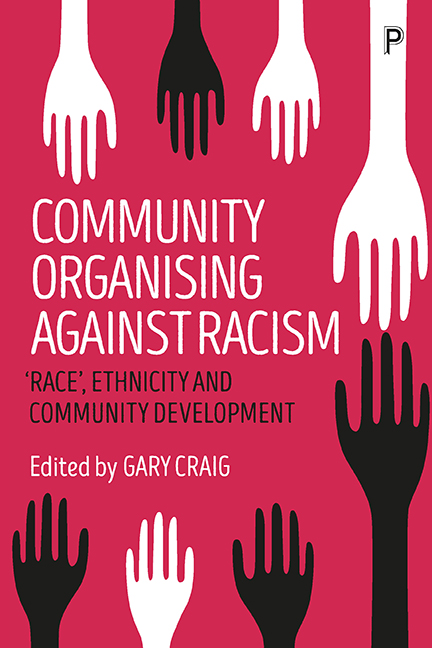Book contents
- Frontmatter
- Dedication
- Contents
- List of figures
- Author biographies
- List of abbreviations
- Introduction
- Section One Community development with ethnic minorities: history, theory, policy
- Section Two Building capacity with BME groups
- Section Three Working with Roma communities
- Section Four Global experience
- Section Five Working across cultural boundaries: ideological and personal reflections
- Afterword: Messages for community development in working with minority groups
- Index
Nine - Cultural identity, migration and community development in Glasgow
Published online by Cambridge University Press: 12 April 2022
- Frontmatter
- Dedication
- Contents
- List of figures
- Author biographies
- List of abbreviations
- Introduction
- Section One Community development with ethnic minorities: history, theory, policy
- Section Two Building capacity with BME groups
- Section Three Working with Roma communities
- Section Four Global experience
- Section Five Working across cultural boundaries: ideological and personal reflections
- Afterword: Messages for community development in working with minority groups
- Index
Summary
This chapter examines two linked stories of community work and migration in Glasgow. One is of the work taken forward by the Scottish Refugee Council with refugees and asylum seekers across the city, the other is of the neighbourhood-level work of Crossroads, a longestablished youth and community association in the Govanhill area of the city. It is set within the shifting context of community work in the city over the years.
Community work and minorities in Glasgow
Through the 1980s and 1990s a strong commitment to community development was established by Scottish local authorities, especially the more strategic Regional Councils (until their abolition in 1996), embracing its values and approaches as a cornerstone of social, educational and economic development.1 However, by the time the local government reorganisation of 1996 had bedded in, many of the new and smaller councils had abandoned or severely reduced their commitment to community development.
Since then there has been a curious, somewhat contradictory path for community development. In many ways it is seen to be strongly embedded in Scottish thinking and culture. The non-governmental organisation (NGO) Community Development Alliance Scotland has over 100 national organisations in its membership, each of which sees community development as a key part of its purpose. Yet, on the ground, very few organisations (either public or third sector) are to be found doing the basic neighbourhood or community work that is at the core of community development.
Working with migrant communities is one of the few areas in which community development and neighbourhood work have remained in place in Glasgow. In this chapter we look at some of the work done in recent years, trying to assess its impact.
Glasgow has been a destination city for migrants for at least 150 years. People from the Scottish Highlands, Ireland, Italy, the Punjab, Uganda, Eastern Europe and many other places have arrived and settled. In the last ten years migration to Glasgow has been predominantly from two main groups: refugees and asylum seekers, mainly from Africa or the Middle East; and people from Central and Eastern Europe, in particular Slovakia and Romania, including a significant number of Roma. For many of these, the neighbourhood of arrival has been Govanhill.
- Type
- Chapter
- Information
- Community Organising against Racism'Race', Ethnicity and Community Development, pp. 159 - 170Publisher: Bristol University PressPrint publication year: 2017



